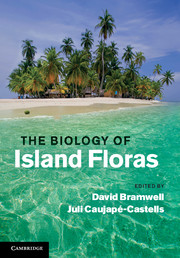Book contents
- Frontmatter
- Contents
- Contributors
- Preface
- 1 Introduction: islands and plants
- 2 The reproductive biology of island plants
- 3 Spatial methodologies in historical biogeography of islands
- 4 Origin and evolution of Hawaiian endemics: new patterns revealed by molecular phylogenetic studies
- 5 Origins and evolution of Galapagos endemic vascular plants
- 6 The plants of the Caribbean islands: a review of the biogeography, diversity and conservation of a storm-battered biodiversity hotspot
- 7 The biogeography of Madagascar palms
- 8 Evolution and biogeography of the flora of the Socotra archipelago (Yemen)
- 9 Biogeography and conservation of the flora of New Caledonia
- 10 Phytogeography and relationships of the Pitcairn Islands flora
- 11 Chromosomes and evolution in New Zealand endemic angiosperms and gymnosperms
- 12 Jesters, red queens, boomerangs and surfers: a molecular outlook on the diversity of the Canarian endemic flora
- 13 Endemism and evolution in Macaronesian and Mediterranean Limonium taxa
- 14 Dispersal, diversity and evolution of the Macaronesian cryptogamic floras
- 15 Invasive alien species and islands
- 16 Ecology, demography and conservation in the Galapagos Islands flora
- 17 New directions and challenges for the conservation of the flora of Madagascar
- 18 Climate change and island floras
- 19 Conservation status of endemic plants on Isla del Coco, Costa Rica: applying IUCN Red List criteria on a small island
- 20 Botanic gardens and the conservation of island floras
- 21 The hazardous future of island floras
- Index
- References
13 - Endemism and evolution in Macaronesian and Mediterranean Limonium taxa
Published online by Cambridge University Press: 07 October 2011
- Frontmatter
- Contents
- Contributors
- Preface
- 1 Introduction: islands and plants
- 2 The reproductive biology of island plants
- 3 Spatial methodologies in historical biogeography of islands
- 4 Origin and evolution of Hawaiian endemics: new patterns revealed by molecular phylogenetic studies
- 5 Origins and evolution of Galapagos endemic vascular plants
- 6 The plants of the Caribbean islands: a review of the biogeography, diversity and conservation of a storm-battered biodiversity hotspot
- 7 The biogeography of Madagascar palms
- 8 Evolution and biogeography of the flora of the Socotra archipelago (Yemen)
- 9 Biogeography and conservation of the flora of New Caledonia
- 10 Phytogeography and relationships of the Pitcairn Islands flora
- 11 Chromosomes and evolution in New Zealand endemic angiosperms and gymnosperms
- 12 Jesters, red queens, boomerangs and surfers: a molecular outlook on the diversity of the Canarian endemic flora
- 13 Endemism and evolution in Macaronesian and Mediterranean Limonium taxa
- 14 Dispersal, diversity and evolution of the Macaronesian cryptogamic floras
- 15 Invasive alien species and islands
- 16 Ecology, demography and conservation in the Galapagos Islands flora
- 17 New directions and challenges for the conservation of the flora of Madagascar
- 18 Climate change and island floras
- 19 Conservation status of endemic plants on Isla del Coco, Costa Rica: applying IUCN Red List criteria on a small island
- 20 Botanic gardens and the conservation of island floras
- 21 The hazardous future of island floras
- Index
- References
Summary
The study of plant speciation on oceanic islands has improved enormously with the help of molecular systematics. Studies have targeted groups present on both the mainland and islands with the aim of understanding plant migration and evolution in isolation. In addition, relatively young volcanic islands give the opportunity to place the evolutionary process in a time frame, by dating molecular trees according to the age of the islands or by relying on the fossil record. Molecular phylogenetics can also be valuable in helping to reconstruct character evolution and understand the syndrome of characters diagnosing oceanic species.
- Type
- Chapter
- Information
- The Biology of Island Floras , pp. 325 - 337Publisher: Cambridge University PressPrint publication year: 2011
References
- 11
- Cited by



